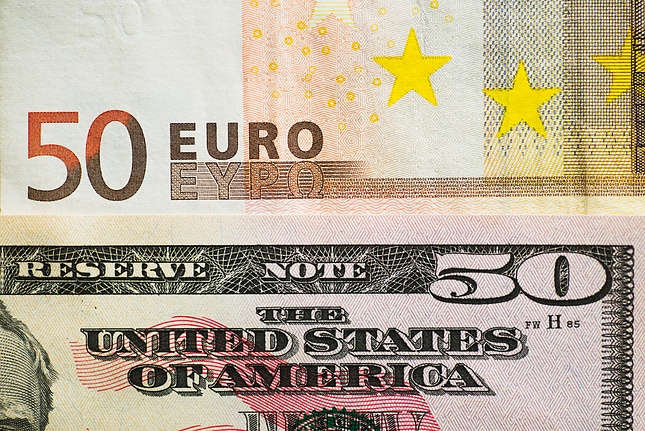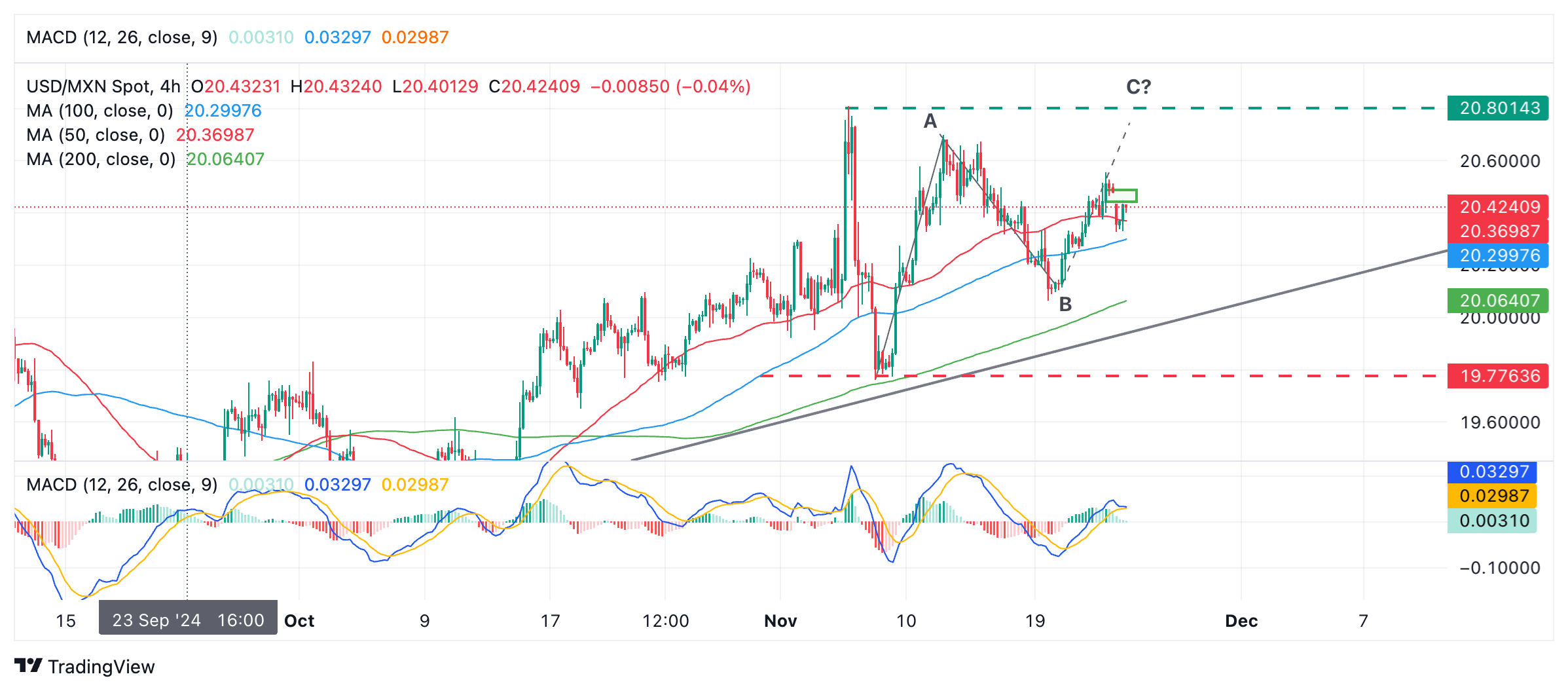- The Mexican Peso recovered at the start of the week following news of the appointment of Scott Bessent as future US Treasury Secretary.
- He is expected to have a tempering influence on inflation and focus on targeting primarily China with tariffs.
- Technically, USD/MXN opens a market gap and is a possible opportunity for traders amid the unfolding leg higher.
The Mexican Peso (MXN) trades higher in its key pairs on Monday, with the MXN doing particularly well against the US Dollar (USD) due to the perception that with the appointment of the new US Treasury Secretary Scott Bessant, US government spending will be more restrained and tariffs will primarily target China. Overall, Bessant is seen as a tempering influence on the future administration’s more inflationary policies.
The Peso is appreciating against the Euro (EUR) after weak Eurozone economic activity data in the form of Purchasing Manager Indices (PMI) on Friday increased expectations that the European Central Bank (ECB) will slash interest rates in December to stimulate growth. Meanwhile, against the Pound Sterling (GBP), the Mexican Peso trades slightly higher for similar reasons to those of the Euro.
The Mexican Peso recovers against USD after Treasury pick
The Mexican Peso is up over half a percent against the US Dollar (USD) on Monday after President-elect Donald Trump announced hedge-fund manager Scott Bessant as the US’s new Treasury Secretary. He will take over from Janet Yellen in January 2025 when Trump begins his presidency.
Although he supports the thrust of Trump’s protectionist and tax-cutting policy agenda, markets view him as a “safe pair of hands” who will likely soften the blow from tariffs and counterbalance inflation by reducing government spending. Based on his prior comments, the two things he is passionate about are cutting the US’s debt pile and thwarting competition from China.
“This election cycle is the last chance for the United States to get out from under a mountain of debt without becoming some kind of European-style socialist democracy," Vijesti News quoted Bessent as telling Bloomberg in August.
The new Treasury Secretary is likely to focus tariffs primarily on China, reducing risk for other major importers such as Mexico and Europe, according to Reuters.
He has advocated a “three-threes” policy in which he will try to reduce the US Budget Deficit to 3% of annual Gross Domestic Product (GDP) from a current estimated 6% in 2024, achieve a 3% annual GDP growth rate, and raise US Crude Oil production by 3 million barrels-a-day, according to Bloomberg News.
Mexican Peso could see strength curtailed by deceleration in inflation
The Mexican Peso’s recovery, however, is likely to be curtailed by market expectations that the Bank of Mexico (Banxico) might cut interest rates more aggressively in future meetings following a deceleration in Mexican inflation in November’s data. Lower interest rates are usually negative for a currency as they reduce foreign capital inflows.
November’s mid-month inflation readings, released on Friday, showed inflation decelerating more than expected. Mexican financial daily El Financiero noted that headline inflation fell to 4.56% year-over-year in the first two weeks of November, below the average of 4.65% based on a Bloomberg survey of analysts.
Official data from Mexico’s Office of Statistics INEGI showed inflation rose by a softer-than-expected 0.37% in the first half of November, compared to estimates of 0.49% and the 0.43% of October’s mid-month reading. Core inflation, meanwhile, rose by only 0.04% compared to the 0.17% expected and 0.23% previous.
Technical Analysis: USD/MXN gaps down at week’s open
USD/MXN gaps down at the start of the new trading week, but according to technical analysis lore, “markets abhor a gap,” and there is a good chance price will rally back up to close the gap, which opened between 20.47 and 20.43 (green rectangle on the chart below) on Monday.
USD/MXN 4-hour Chart
The cliff drop occurred during the probable unfolding of a third “C” wave higher in what could be the completion of a Measured Move pattern. These are three-wave patterns resembling zig-zags in which the first and the third waves (A and C) are of a similar length.
USD/MXN looks range bound in the short term as it oscillates between the 19.70s and 20.80s. The extension of wave C corresponds to an up leg unfolding within this sideways consolidation towards its ceiling (green dashed line).
The (blue) Moving Average Convergence Divergence (MACD) indicator had been rising back above the zero line in line with the bullish bias, and although it fell back down and almost crossed below the red signal line during the opening of the market gap, it has not quite achieved the cross over so far, suggesting the retention of the bullish advantage.
A break above the 20.55 November 22 high would re-confirm wave C extending to at least the same level as the top of wave A at 20.69, possibly even to 20.80 and the range ceiling. The opening of the gap and the assumption it will soon close could also provide an opportunity for traders wishing to enter long positions at a more favorable price.
Mexican Peso FAQs
The Mexican Peso (MXN) is the most traded currency among its Latin American peers. Its value is broadly determined by the performance of the Mexican economy, the country’s central bank’s policy, the amount of foreign investment in the country and even the levels of remittances sent by Mexicans who live abroad, particularly in the United States. Geopolitical trends can also move MXN: for example, the process of nearshoring – or the decision by some firms to relocate manufacturing capacity and supply chains closer to their home countries – is also seen as a catalyst for the Mexican currency as the country is considered a key manufacturing hub in the American continent. Another catalyst for MXN is Oil prices as Mexico is a key exporter of the commodity.
The main objective of Mexico’s central bank, also known as Banxico, is to maintain inflation at low and stable levels (at or close to its target of 3%, the midpoint in a tolerance band of between 2% and 4%). To this end, the bank sets an appropriate level of interest rates. When inflation is too high, Banxico will attempt to tame it by raising interest rates, making it more expensive for households and businesses to borrow money, thus cooling demand and the overall economy. Higher interest rates are generally positive for the Mexican Peso (MXN) as they lead to higher yields, making the country a more attractive place for investors. On the contrary, lower interest rates tend to weaken MXN.
Macroeconomic data releases are key to assess the state of the economy and can have an impact on the Mexican Peso (MXN) valuation. A strong Mexican economy, based on high economic growth, low unemployment and high confidence is good for MXN. Not only does it attract more foreign investment but it may encourage the Bank of Mexico (Banxico) to increase interest rates, particularly if this strength comes together with elevated inflation. However, if economic data is weak, MXN is likely to depreciate.
As an emerging-market currency, the Mexican Peso (MXN) tends to strive during risk-on periods, or when investors perceive that broader market risks are low and thus are eager to engage with investments that carry a higher risk. Conversely, MXN tends to weaken at times of market turbulence or economic uncertainty as investors tend to sell higher-risk assets and flee to the more-stable safe havens.
Information on these pages contains forward-looking statements that involve risks and uncertainties. Markets and instruments profiled on this page are for informational purposes only and should not in any way come across as a recommendation to buy or sell in these assets. You should do your own thorough research before making any investment decisions. FXStreet does not in any way guarantee that this information is free from mistakes, errors, or material misstatements. It also does not guarantee that this information is of a timely nature. Investing in Open Markets involves a great deal of risk, including the loss of all or a portion of your investment, as well as emotional distress. All risks, losses and costs associated with investing, including total loss of principal, are your responsibility. The views and opinions expressed in this article are those of the authors and do not necessarily reflect the official policy or position of FXStreet nor its advertisers. The author will not be held responsible for information that is found at the end of links posted on this page.
If not otherwise explicitly mentioned in the body of the article, at the time of writing, the author has no position in any stock mentioned in this article and no business relationship with any company mentioned. The author has not received compensation for writing this article, other than from FXStreet.
FXStreet and the author do not provide personalized recommendations. The author makes no representations as to the accuracy, completeness, or suitability of this information. FXStreet and the author will not be liable for any errors, omissions or any losses, injuries or damages arising from this information and its display or use. Errors and omissions excepted.
The author and FXStreet are not registered investment advisors and nothing in this article is intended to be investment advice.
Recommended content
Editors’ Picks

EUR/USD holds above 1.0450 German sentiment data
EUR/USD stays in positive territory above 1.0450 after retracing a portion of its bullish opening gap. The data from Germany showed that the IFO - Current Assessment Index declined to 84.3 in November from 85.7, while the Expectations Index edged lower to 87.2 from 87.3.

GBP/USD pulls back toward 1.2550 as US Dollar sell-off pauses
GBP/USD is falling back toward 1.2550 in the European session on Monday after opening with a bullish gap at the start of a new week. A pause in the US Dollar decline alongside the US Treasury bond yields weighs down on the pair. Speeches from BoE policymakers are eyed.

Gold price manages to hold above $2,650 amid sliding US bond yields
Gold price maintains its heavily offered tone through the early European session on Monday, albeit manages to hold above the $2,650 level and defend the 100-period Simple Moving Average (SMA) on the 4-hour chart. Scott Bessent's nomination as US Treasury Secretary clears a major point of uncertainty for markets.

Bitcoin consolidates after a new all-time high of $99,500
Bitcoin remains strong above $97,700 after reaching a record high of $99,588. At the same time, Ethereum edges closer to breaking its weekly resistance, signaling potential gains. Ripple holds steady at a critical support level, hinting at continued upward momentum.

Eurozone PMI sounds the alarm about growth once more
The composite PMI dropped from 50 to 48.1, once more stressing growth concerns for the eurozone. Hard data has actually come in better than expected recently – so ahead of the December meeting, the ECB has to figure out whether this is the PMI crying wolf or whether it should take this signal seriously. We think it’s the latter.

Best Forex Brokers with Low Spreads
VERIFIED Low spreads are crucial for reducing trading costs. Explore top Forex brokers offering competitive spreads and high leverage. Compare options for EUR/USD, GBP/USD, USD/JPY, and Gold.
